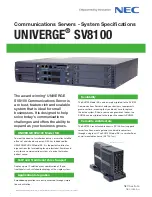
66
number is used to guard against accidental receipt of unintended
data and malicious use by the attackers if the ISN (Initial Sequence
Number) is generated randomly. Forged packets with valid sequence
numbers can be used to gain trust from the receiving host. Attackers
can then gain access to the compromised system. Note that this
attack affects only the TCP packets originated or terminated at the
Internet Security Router.
Sequence Number Out of Range
Check:
Protect against TCP out of range sequence
number attacks. An attacker can send a TCP packet to cause an
intrusion detection system (IDS) to become unsynchronized with the
data in a connection. Subsequent frames sent in that connection may
then be ignored by the IDS. This may indicate an unsuccessful attempt
to hijack a TCP session.
ICMP Verbose:
Check or un-check this option to enable or disable
protection against ICMP error message attacks. ICMP messages can
be used to fold your network with undesired traffic.
Max IP Fragment Count:
Enter the maximum number of fragments
the Firewall should allow for every IP packet. This option is required if
your connection to the ISP is through PPPoE. This data is used during
transmission or reception of IP fragments. When large sized packets
are sent via NES Storage Server with BT, the packets are chopped into
fragments as large as MTU (Maximum Transmission Unit). By default,
this number is set to 45. If MTU of the interface is 1500(default for
Ethernet), then there can be a maximum of 45 fragments per IP packet.
If the MTU is less, then there can be more number of fragments and
this number should be increased.
Minimum IP Fragment Size:
Enter the Minimum size of IP fragments
to be allowed through Firewall. This limit will not be enforced on the
last fragment of the packet. If the Internet traffic is such that it
generates many small sized fragments, this value can be decreased.
This can be found if there are lots of packet losses, degradation in
speed and if the flowing log message is generated very often:
“fragment of size less than configured minimum fragment size
detected”.
5.
Apply & Cancel
:
:
:
:
Click on
Apply
button to continue. Click on
Cancel
button to clear
the settings on this page.
6.
DoS Attacks Blocking List
:
:
:
:
The list shows all the DoS attacks blocking items.
Summary of Contents for WE-1530
Page 1: ...1 ...
Page 15: ...15 Step 1 Go to Start Settings Network Connections and then select Local Area Connection ...
Page 16: ...16 Step 2 Click on Properties Step 3 Double click on Internet Protocol TCP IP ...
Page 19: ...19 ...
Page 67: ...67 ...
Page 77: ...77 Step 2 Fill in blank address field with 192 168 1 1 ...
Page 92: ...92 ...
Page 97: ...97 Step 2 Click on Add a printer item ...
Page 114: ...114 ...
Page 116: ...116 ...
Page 165: ...165 ...
Page 190: ...190 ...
Page 194: ...194 Each block shows configuration status you may click Refresh to update the screen list ...
Page 215: ...215 ...
Page 282: ...282 Step 2 Fill in the form as required and then click on Create Account button ...
Page 284: ...284 Step 5 Click on login Step 6 Click My Services after logging in ...
Page 285: ...285 Step 7 Click Add New Hostname Step 8 Please click on Add Dynamic DNS Host ...
















































